I have been living in Tbilisi for six years, and I have prepared a list of top things to do in Tbilisi, with a 2 days Tbilisi itinerary for you. I am writing the most important places in Tbilisi that you can easily visit in a weekend. I am sharing the same itinerary I use when I have guests visiting, in the order I take them around. Ok then, let’s go on a Tbilisi tour together.
I also recommend reading my other article that contains everything you need to know before visiting Tbilisi. There, you can find detailed information about accommodation, transportation, dining, shopping, and more.
The Ultimate Tbilisi Travel Guide
Where To Stay In Tbilisi, Georgia?

Things To Do in Tbilisi
Abanotubani: Abanotubani, meaning “Bathing District”, is an ancient and historic part of the city, known for its sulfur baths. The colorful houses with balconies built on the rocks are also quite beautiful.
Sulfur Baths: Like Turkish bath culture, Tbilisi also has a tradition of baths, and the meaning of Tbilisi is “warm”, it comes from these warm water sources.

Leghvtakhevi Waterfall: This waterfall in the middle of the city can be reached by passing through the sulfur baths. It’s not a very large waterfall, but it’s worth a visit when you are in the Abanotubani area. In winter, you might see it frozen.
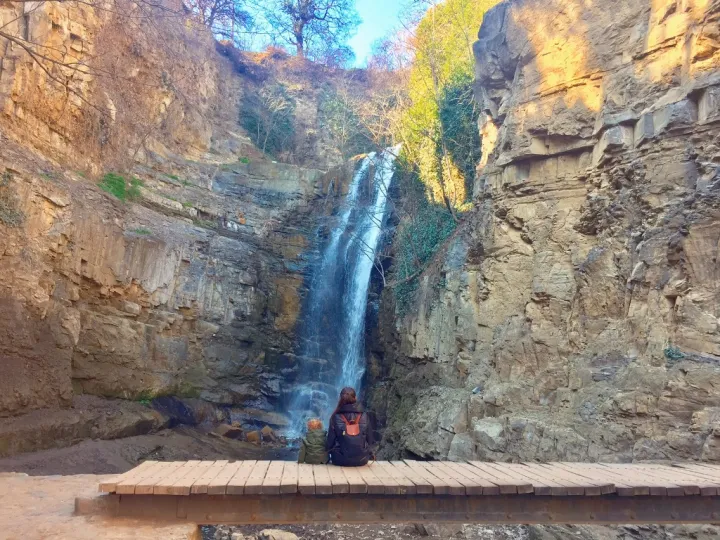
Metekhi Church: Perched on the cliffs along the Kura River, this church was first built in the 12th century and has been rebuilt several times throughout history. In front of the church stands a bronze equestrian statue of Vakhtang Gorgasali, the founder of the city. This spot offers beautiful views for photography.
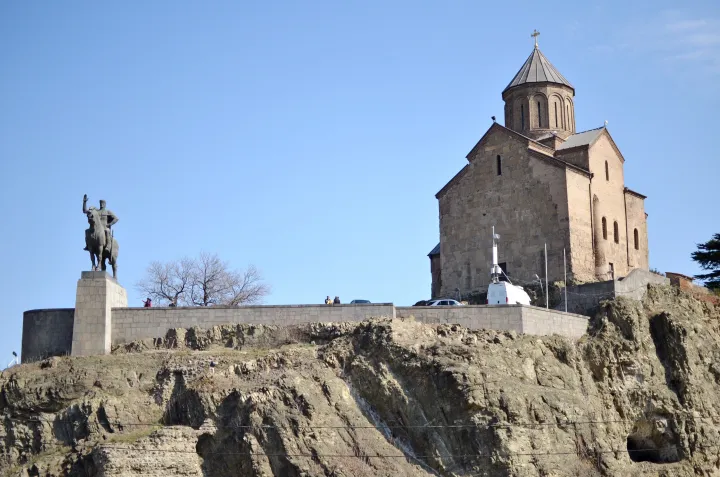
Queen Darejan Palace: Also known as Sachino Palace, this was the 18th-century summer residence of Queen Darejan, the wife of King Erekle II. It is one of the two oldest preserved palaces in Tbilisi and offers a lovely city view.

Narikala Fortress: Overlooking Tbilisi and the Kura River, this fortress dates back to the 4th century. From its walls, you can see panoramic views of the Silk Road. To visit, you can take the cable car, which costs 2.5 GEL one-way, but you’ll need a MetroMoney card. You should definitely go up to see the best views of the city, my recommendation is to take the cable car up and walk down.
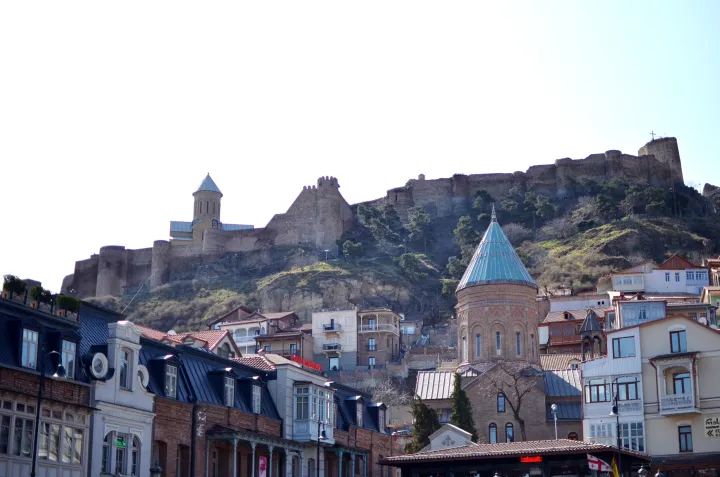
Saint Nicholas Church: Located within the Narikala Fortress complex, this church was originally built in the 13th century but was later destroyed in a fire. It was rebuilt in the 1990s and now stands in its current form.
Mother of Georgia (Kartlis Deda): This giant statue on Sololaki Hill holds a bowl of wine for friends and a sword for enemies, symbolizing Georgians’ priorities of hospitality and freedom. After a short walk from the cable car station, you will see it.
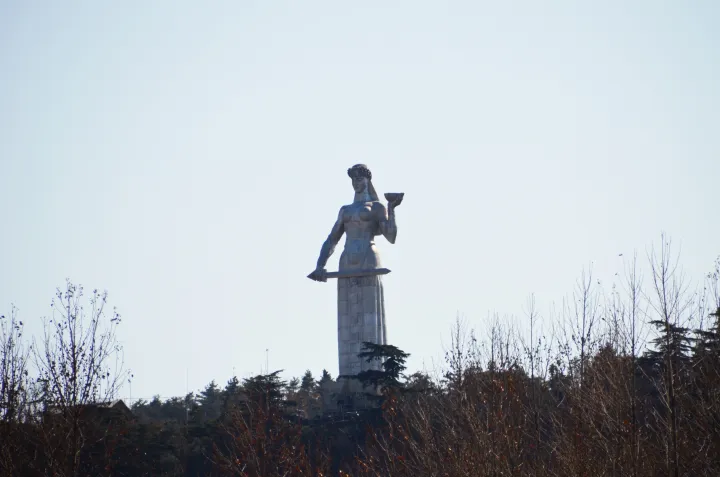
Tbilisi Botanical Garden: Evolving from the royal gardens of ancient times into an arboretum, it was established in its current form in 1845. The Tbilisi Botanical Garden, spanning 128 hectares, is home to over 3,500 species of plants, both local and international, making it an ideal place for walking. The entrance is right in front of the cable car station, you can continue to the botanical garden from there if you want.
Peace Bridge: This curving pedestrian bridge over the Kura River has become one of Tbilisi’s symbols, though its modern architecture initially sparked controversy. Locally, it’s also known as the Always Bridge, humorously likened to the shape of a woman’s sanitary pad (referencing the Always brand).
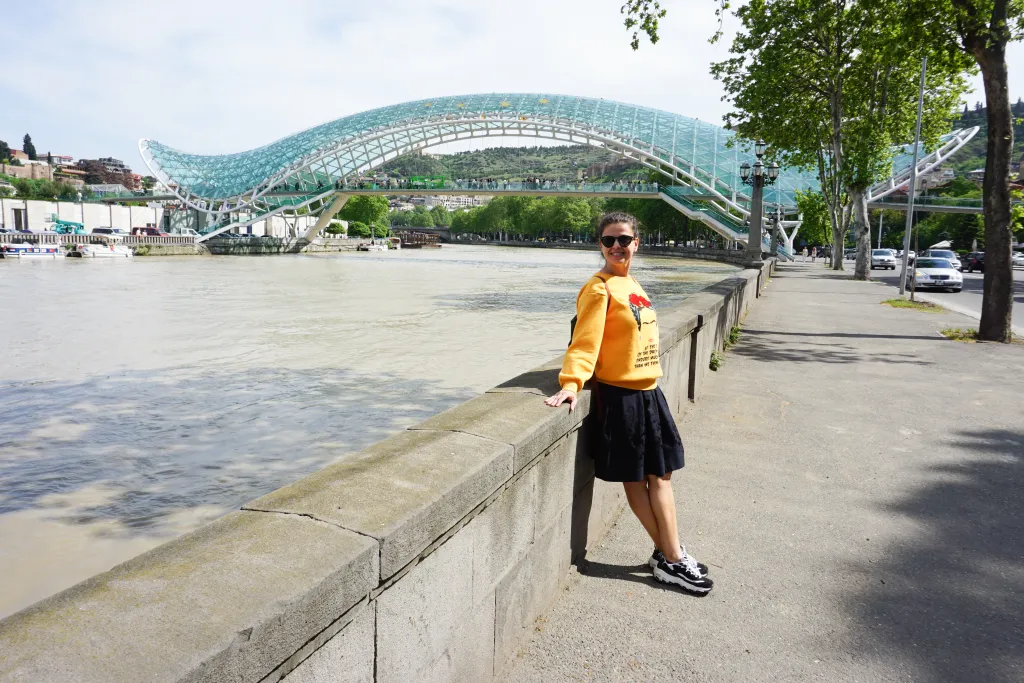
Old Tbilisi: You will likely spend most of your time here. Many of the structures I’ve mentioned throughout this article are located around the old city. Old Tbilisi is also where you’ll find some of the city’s best cafes and bars. The traditional old houses with their intricately carved balconies are quite photogenic. There are also galleries and small gift shops for art lovers.
Freedom Square: This is the most famous square in Tbilisi, where you will see a large monument with a statue of St. George. During the Soviet Union, the square was first called “Beria Square” and then “Lenin Square”. In 1918, after the fall of the Russian Empire and the establishment of the Georgian Republic, the name was changed to Freedom Square.
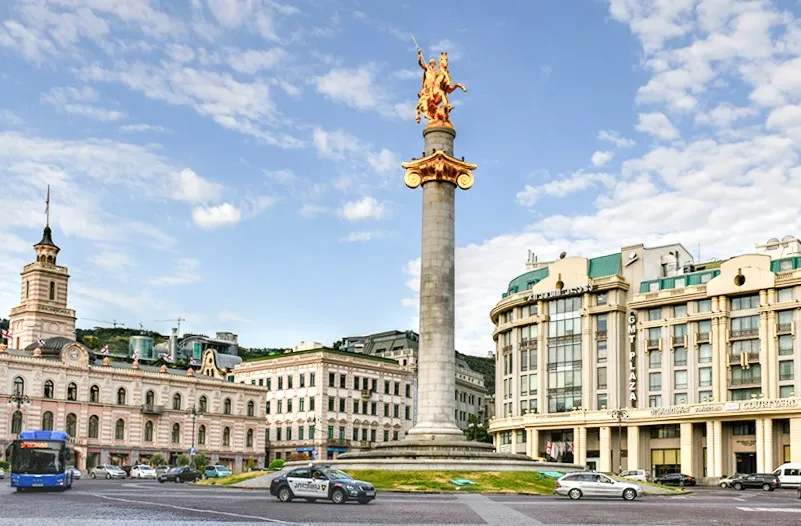
Gabriadze Clock Tower: Built in 2010 by Rezo Gabriadze, this unique clock in Old Tbilisi has a small angel that strikes the bell every hour. If you’re there at noon or 7 PM, the tiny metal curtain in the center of the clock opens and a few puppets spin around.
National Museum of Georgia: Located on Rustaveli Avenue, this museum helps you understand the country’s ancient and recent history. Initially founded in 1825 by the Russian Imperial Geographical Society, its current form consists of collections from 13 museums. The local tourism office is also here – you can take a city map.

Rustaveli Avenue: Named after the medieval Georgian poet Shota Rustaveli, this avenue starts from Freedom Square and continues with some of the important buildings of the city. I recommend you to walk along this 1.5 km long avenue with many restaurants and shops.
Tbilisi Opera and Ballet Theatre: For those interested in the visual arts, I recommend watching a performance here. You can check the schedule of ballets or operas at opera.ge. Note that you cannot enter the opera house without a ticket.

Sameba Cathedral: Also known as the Holy Trinity Cathedral, built in 2004, it’s the largest church in Georgia at 101 meters tall. Its golden dome is visible from almost anywhere in Tbilisi. The complex includes a monastery, school, hotel, and nine chapels, five of which are underground. It’s not a historic building, it’s still majestic and impressive.
Marjanishvili Street: The buildings on this classically renovated street seem to date back to the 18th-19th centuries. Each building is artistically decorated and painted in different colors. The street is lined with lamp posts reminiscent of old classic times, and even the trash bins are specially designed. This area is also known among the locals as the Turkish Street due to the numerous Turkish shops and restaurants.
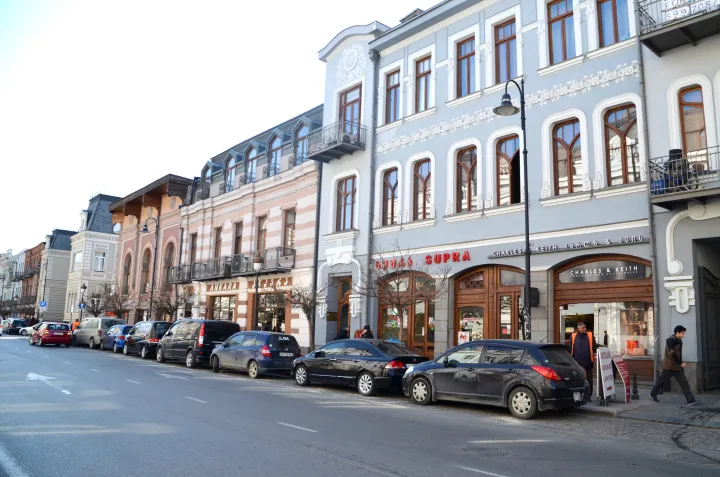
Mtatsminda Park: There is a large amusement park on Mtatsminda hill, which you can reach by funicular or buses numbered 90 and 124, and there is a market on weekends. Entrance is free if you don’t participate in the games in the park. This is the highest viewpoint over the city, worth visiting if you have extra time.
Vake Park: Opened in 1946, this park is located in Vake. It’s a popular meeting spot for locals, especially in good weather. I recommend it for families with children, those who want to relax on the grass, and walk in fresh air.

The Chronicle of Georgia: Near the Tbilisi Sea, the Chronicle of Georgia Monument was started by Zurab Tsereteli in 1985. After climbing some stairs, you’re greeted by 16 columns, each 30-35 meters high. The upper parts feature kings, queens, and heroes, while the lower parts depict stories from the life of Jesus.
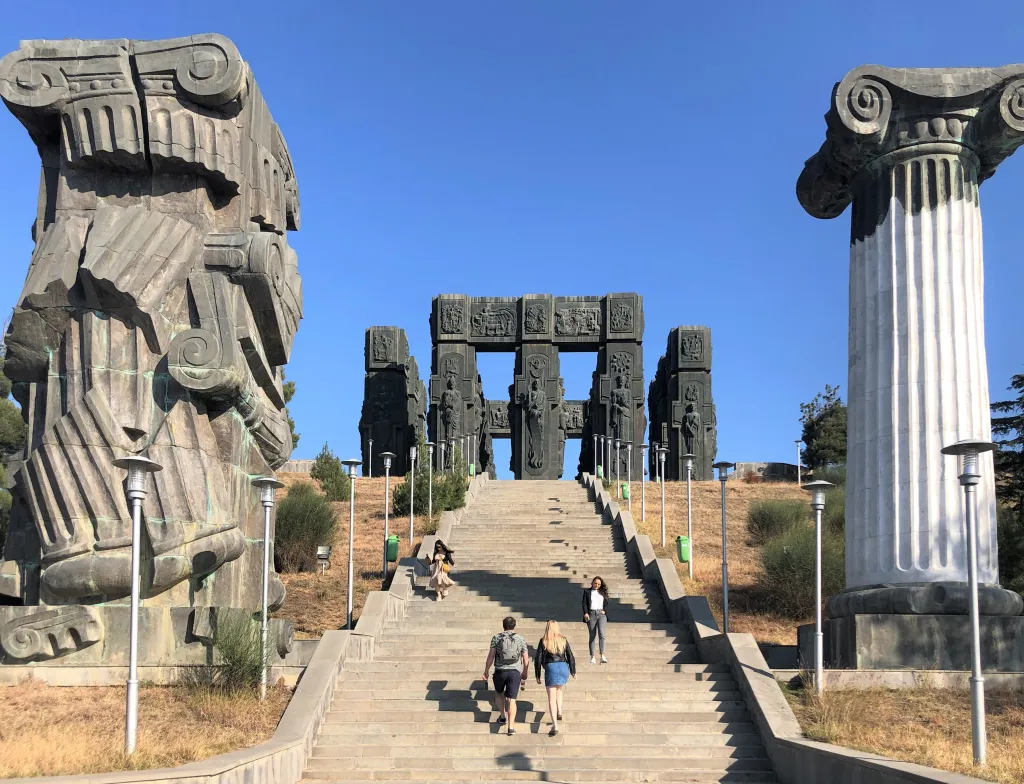
Meidan Bazaar: Located in an underpass at Old Tbilisi square, this authentic market offers every kind of souvenir and local product you can imagine. Even if you don’t shop, the atmosphere is worth seeing.
Dry Bridge Market: I will recommend a flea market for those who likes shopping. Don’t forget to visit the antique market at Dry Bridge, where both old items and Georgian handicrafts and artworks are sold. It is open every day from 10:00-17:00 but there are more sellers on weekends.
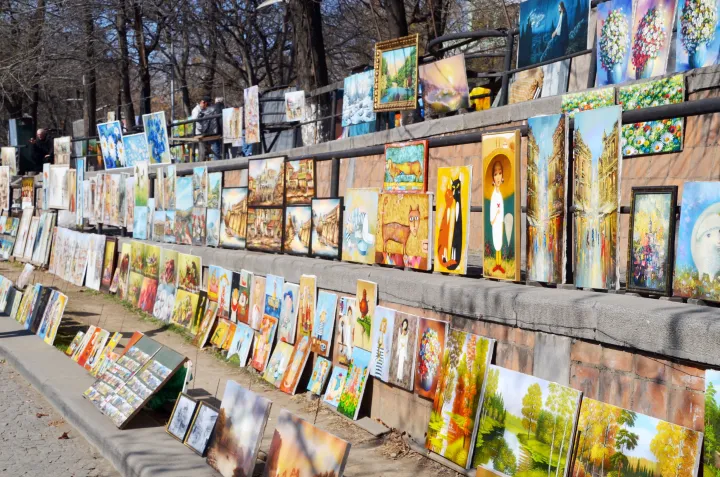
2-Day Tbilisi Tour Itinerary
If you only have one day in Tbilisi, you can follow the first day’s itinerary.
First Day Itinerary in Tbilisi
- Start with Abanotubani and the sulfur baths. You can take beautiful photos of the fortress and mosque from the domed roofs. Walk to the end to reach Leghvtakhevi Waterfall.
- On the way back, visit Metekhi Church across the river for nice city view photos.
- Near the church, there’s a small park with a piece of the Berlin Wall.
- A bit uphill, you can take photos of the city from Queen Darejan Palace with its lacy balconies.
- Take the cable car from Rike Park to Narikala hill, where you’ll find Kartlis Deda and Narikala Fortress. You can go down on foot through stairs and alleyways.
- Visit Gallery 27 and step inside the stained-glass house.
- Walk around the recently renovated Gudiashvili Square for some colorful houses.
- In Old Tbilisi Square, visit Meidan Bazaar for souvenirs.
- Walk towards Gabriadze Clock Tower via Erekle II and Shavteli streets. On the way, you can also visit Sioni Cathedral.
- Visit the Peace Bridge for photos.
- If you still have time, walk to Freedom Square and Rustaveli Avenue.
Second Day Itinerary in Tbilisi
- Visit Sameba Cathedral, Georgia’s tallest cathedral, in the morning.
- Explore Dry Bridge, a flea market with art and crafts.
- If you enjoy museums, visit the National Museum of Georgia on Rustaveli Avenue.
- Walk along Rustaveli Avenue if you didn’t have time on the first day.
- Another option is to cross the bridge to walk along Marjanishvili Street, and then visit Fabrika for a meal or drink.
- Although a bit far from the city center, the Chronicle of Georgia is worth visiting.
- Take the funicular or buses to Mtatsminda hill for a panoramic view and a walk in the park. If you have kids, they might enjoy the amusement park there.
Places to Visit in Tbilisi with Children
- Experimentorium, a science museum, is great for kids.
- The amusement park on Mtatsminda hill, is fun for kids, though some rides are quite old.
- Dedaena Park and Vake Park are great for kids to run and play in the city center.
- My son’s favorite activity was watching the angel ring the bell at Gabriadze Clock Tower; we often visited there.
- The cable car to Kartlis Deda was another of his favorites.
- Tbilisi has a Museum of Illusions, which kids like, but it’s similar to those in other cities.
- Tbilisi Digital Space, a digital art museum, also attracts kids.
I hope my guide on Things to Do in Tbilisi helps you create a perfect tour. I might have missed something, so feel free to ask in the comments or share your own recommendations. Have a great holiday!
For more articles and photos, don’t forget to follow me!
Instagram: lifetime.journey
Tiktok: ihdcnwbcmw.com
Facebook: ihdcnwbcmw.com
Discover more from LIFETIME JOURNEY
Subscribe to get the latest posts sent to your email.